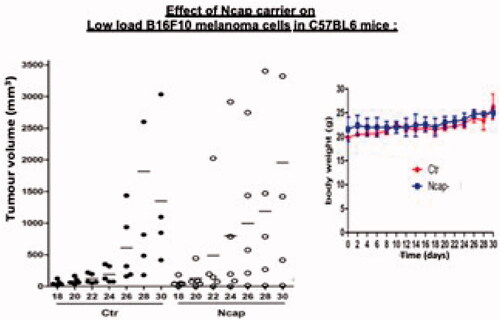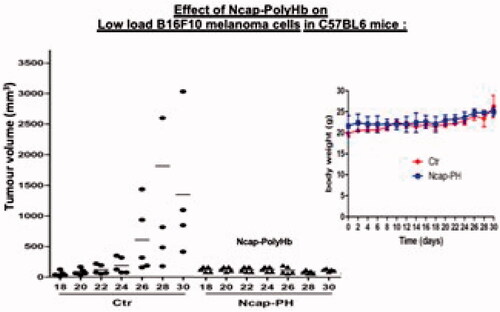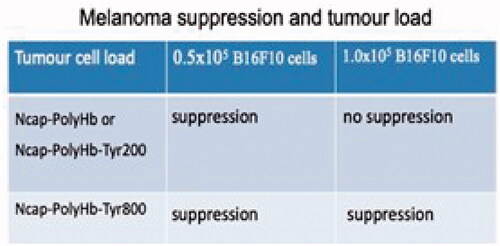Figures & data
Figure 1. (a) Preparation: first by crosslinking haemoglobin and tyrosinase into a soluble nanobiotherapeutic complex of poly-[haemoglobin-tyrosinase] that functions as an oxygen therapeutic with enzyme activity. This is then bioencapsulated into a polymer–lipid artificial cell nanocarrier. (b) This is place in a 2D culture with B16F10 melanoma cell to study its effect. This is more suitable for sample collections to analyze the mechanism of action on the tumour cells. (c) 3D culture is more comparable to the in vivo condition that would allow us to analyze the in vivo action and dosage needed for animal study. (d) Local injection to C57BL/6 mice to study the inhibition of B16F10 melanoma growth. (e) Sites of action of injected nanoencapsulated PolyHb-tyrosinase.
![Figure 1. (a) Preparation: first by crosslinking haemoglobin and tyrosinase into a soluble nanobiotherapeutic complex of poly-[haemoglobin-tyrosinase] that functions as an oxygen therapeutic with enzyme activity. This is then bioencapsulated into a polymer–lipid artificial cell nanocarrier. (b) This is place in a 2D culture with B16F10 melanoma cell to study its effect. This is more suitable for sample collections to analyze the mechanism of action on the tumour cells. (c) 3D culture is more comparable to the in vivo condition that would allow us to analyze the in vivo action and dosage needed for animal study. (d) Local injection to C57BL/6 mice to study the inhibition of B16F10 melanoma growth. (e) Sites of action of injected nanoencapsulated PolyHb-tyrosinase.](/cms/asset/cd1c184c-4a7e-4fed-a89e-6f3c468bb044/ianb_a_1918134_f0001_c.jpg)
Figure 2. The effects of different components on B16F10 melanoma cell tyrosine levels in 3 D cell culture at 0 h, 24 h and 48 h. Ctr: control with saline. Ncap: empty polylactide nanocarrier. Ncap-PH: polylactide nanocarrier containing polyhemoglobin. Ncap-PH-TYR200 and Ncap-PH-TYR400 polylactide nanocarrier containing poly-[haemoglobin-tyrosinase] with 200 units or 400 units of tyrosinase. Results are expressed as mean + s.e.m. Single asterisk indicates p < 0.05. Double asterisk indicates p < 0.005 compared with control.
![Figure 2. The effects of different components on B16F10 melanoma cell tyrosine levels in 3 D cell culture at 0 h, 24 h and 48 h. Ctr: control with saline. Ncap: empty polylactide nanocarrier. Ncap-PH: polylactide nanocarrier containing polyhemoglobin. Ncap-PH-TYR200 and Ncap-PH-TYR400 polylactide nanocarrier containing poly-[haemoglobin-tyrosinase] with 200 units or 400 units of tyrosinase. Results are expressed as mean + s.e.m. Single asterisk indicates p < 0.05. Double asterisk indicates p < 0.005 compared with control.](/cms/asset/f94df8d4-d3fb-426f-8d18-ad8c32e86cd5/ianb_a_1918134_f0002_b.jpg)
Figure 3. The effects of different components on viable B16F10 melanoma cell count in 3 D cell culture at 24 h. Ctr: control with saline. Ncap: empty polylactide nanocarrier. Ncap-PH: polylactide nanocarrier containing polyhaemoglobin. Ncap-PH-TYR200 and Ncap-PH-TYR400: polylactide nanocarrier containing poly-[haemoglobin-tyrosinase] with 200 units or 400 units of tyrosinase. Results are expressed as mean + s.e.m. Single asterisk indicates p < 0.05. Double asterisk indicates p < 0.005 compared with control.
![Figure 3. The effects of different components on viable B16F10 melanoma cell count in 3 D cell culture at 24 h. Ctr: control with saline. Ncap: empty polylactide nanocarrier. Ncap-PH: polylactide nanocarrier containing polyhaemoglobin. Ncap-PH-TYR200 and Ncap-PH-TYR400: polylactide nanocarrier containing poly-[haemoglobin-tyrosinase] with 200 units or 400 units of tyrosinase. Results are expressed as mean + s.e.m. Single asterisk indicates p < 0.05. Double asterisk indicates p < 0.005 compared with control.](/cms/asset/563ca859-a606-4c7b-9ab8-3e310a36498f/ianb_a_1918134_f0003_b.jpg)
Figure 4. The effects of different components on B16F10 melanoma cell cycle in 3D cell culture at 24 h and 48 h. Ctr: control with saline. Ncap-PH: polylactide nanocarrier containing polyhaemoglobin. Ncap-PH-TYR50 polylactide nanocarrier containing poly-[haemoglobin-tyrosinase] with 50 units of tyrosinase.
![Figure 4. The effects of different components on B16F10 melanoma cell cycle in 3D cell culture at 24 h and 48 h. Ctr: control with saline. Ncap-PH: polylactide nanocarrier containing polyhaemoglobin. Ncap-PH-TYR50 polylactide nanocarrier containing poly-[haemoglobin-tyrosinase] with 50 units of tyrosinase.](/cms/asset/f26d2a5d-0fc4-4be9-8671-38845522b2a7/ianb_a_1918134_f0004_b.jpg)
Figure 5. The effects of different components on B16F10 melanoma migration in 3D cell culture. Ctr: control with saline. Ncap-PH: polylactide nanocarrier containing polyhemoglobin. Ncap-PH-TYR50 polylactide nanocarrier containing poly-[haemoglobin-tyrosinase] with 50 units of tyrosinase. Results are expressed as mean + s.e.m. Single asterisk indicates p < 0.05. Double asterisk indicates p < 0.005 compared with control.
![Figure 5. The effects of different components on B16F10 melanoma migration in 3D cell culture. Ctr: control with saline. Ncap-PH: polylactide nanocarrier containing polyhemoglobin. Ncap-PH-TYR50 polylactide nanocarrier containing poly-[haemoglobin-tyrosinase] with 50 units of tyrosinase. Results are expressed as mean + s.e.m. Single asterisk indicates p < 0.05. Double asterisk indicates p < 0.005 compared with control.](/cms/asset/14eac5f6-9e67-46a4-890a-b16ff1b2eb61/ianb_a_1918134_f0005_b.jpg)
Figure 6. In vivo effect on growth of melanoma and body weight. Single asterisk indicates p < 0.05 compared with control. n = 6 mice for each group. Ctr: control with saline. Ncap-PH-TYR400 and Ncap-PH-TYR 800, polylactide nanocarrier containing poly-[haemoglobin-tyrosinase] with 400 and 800 units of tyrosinase.
![Figure 6. In vivo effect on growth of melanoma and body weight. Single asterisk indicates p < 0.05 compared with control. n = 6 mice for each group. Ctr: control with saline. Ncap-PH-TYR400 and Ncap-PH-TYR 800, polylactide nanocarrier containing poly-[haemoglobin-tyrosinase] with 400 and 800 units of tyrosinase.](/cms/asset/7392e3c9-8dd1-4f86-9f31-9a3490d595bc/ianb_a_1918134_f0006_c.jpg)
Figure 7. In vivo effect on growth of melanoma and body weight. n = 6 mice for each group. Ctr control with saline. Ncap: empty polylactide nanocarrier.

Figure 8. In vivo effect on the growth of melanoma and body weight. n = 6 mice for each group. Ctr: control with saline. PH-TYR400 soluble poly-[haemoglobin-tyrosinase] containing 400 units of tyrosinase.
![Figure 8. In vivo effect on the growth of melanoma and body weight. n = 6 mice for each group. Ctr: control with saline. PH-TYR400 soluble poly-[haemoglobin-tyrosinase] containing 400 units of tyrosinase.](/cms/asset/9728225e-3b88-4d8f-8625-1bbe5a1d0078/ianb_a_1918134_f0008_c.jpg)
Figure 9. In vivo effect on growth of melanoma and body weight, n = 6 mice for each group. Ctr: control with saline. Ncap-PH: polylactide nanocarrier containing polyhaemoglobin.

Figure 10. Effect of tumour cell load on the suppression of tumour growth. Ncap-PolyHb or Ncap-PolyHb-Tyr200 (nanocarrier containing polyhaemoglobin or nanocarrier containing polyhaemoglobin-tyrosinase with 200 units of tyrosinase) could suppress the growth of the tumour cell load of 0.5 × 105 but not when the tumour cell load was increased to 1.0 × 1010. When the tumour cell load was increased to 1.0 × 1010 Ncap-PolyHb-Tyr800 (nanocarrier containing polyhaemoglobin-tyrosinase with 800 units of tyrosinase) was needed to suppress the growth.

Figure 11. (a) In vivo effect of Ncap-PH-TYR800 (polylactide nanocarrier containing poly-[haemoglobin-tyrosinase] with 800 units of tyrosinase) compared to Ctr (control with saline) on higher tumour load (1.0 × 105 B16F10 melanoma tumour cells: 0.15 ml Ncap-PH-TYR800. n = 6 mice for each group. Left: tumour volumes followed every 2 days for 30 days. Right: effect on growth as shown by body weight. (b) Pathology report of the injection site: in vivo effect of Ncap-PH-TYR800 (polylactide nanocarrier containing poly-[haemoglobin-tyrosinase] with 800 units of tyrosinase) compared to Ctr (control with saline) on higher tumour load (1.0 × 105 B16F10 melanoma tumour cells: 0.15 ml Ncap-PH-TYR800.
![Figure 11. (a) In vivo effect of Ncap-PH-TYR800 (polylactide nanocarrier containing poly-[haemoglobin-tyrosinase] with 800 units of tyrosinase) compared to Ctr (control with saline) on higher tumour load (1.0 × 105 B16F10 melanoma tumour cells: 0.15 ml Ncap-PH-TYR800. n = 6 mice for each group. Left: tumour volumes followed every 2 days for 30 days. Right: effect on growth as shown by body weight. (b) Pathology report of the injection site: in vivo effect of Ncap-PH-TYR800 (polylactide nanocarrier containing poly-[haemoglobin-tyrosinase] with 800 units of tyrosinase) compared to Ctr (control with saline) on higher tumour load (1.0 × 105 B16F10 melanoma tumour cells: 0.15 ml Ncap-PH-TYR800.](/cms/asset/10936928-b5d6-4642-a714-3bcd49260412/ianb_a_1918134_f0011_c.jpg)
Data availability statement
More details and data are available in http://www.medicine.mcgill.ca/artcell
